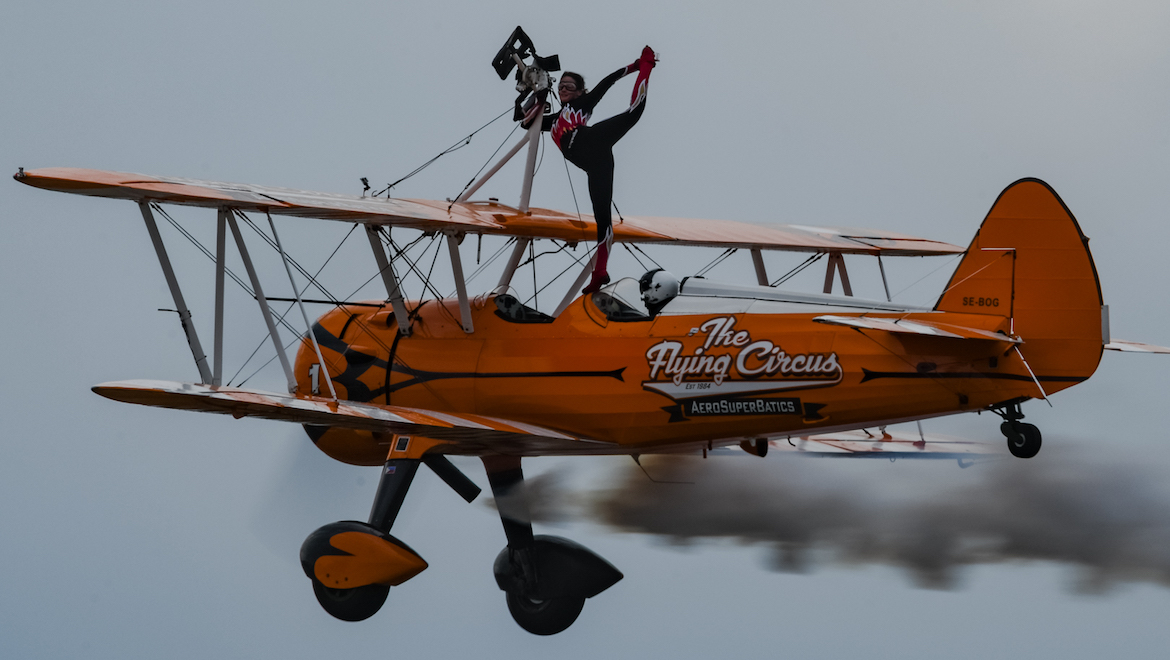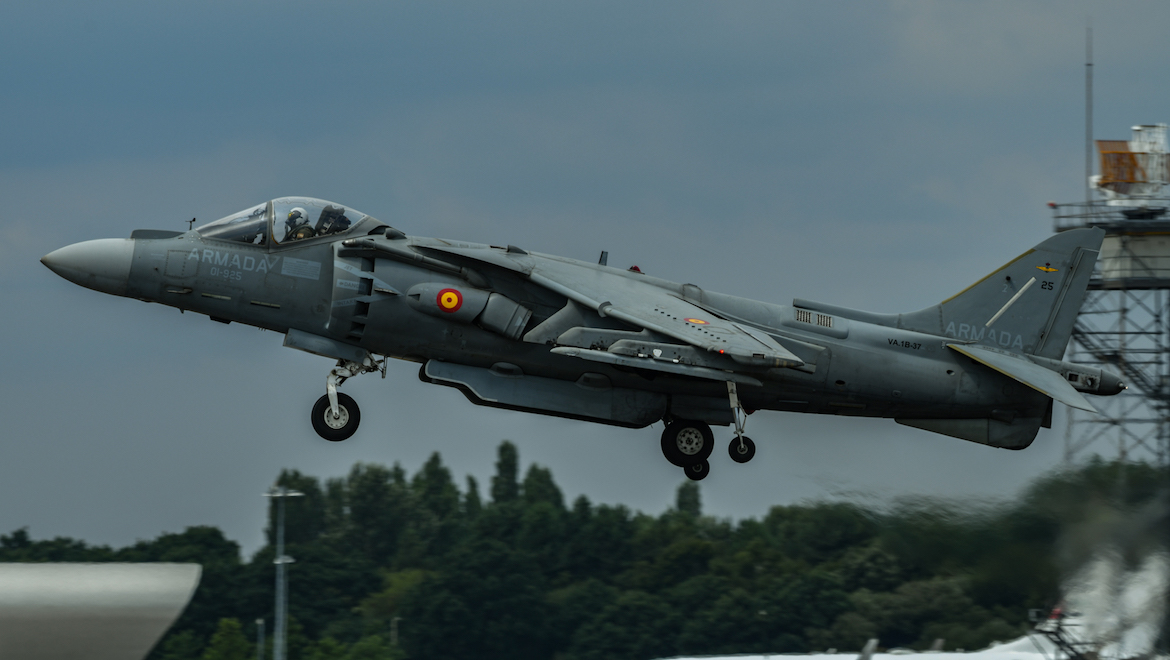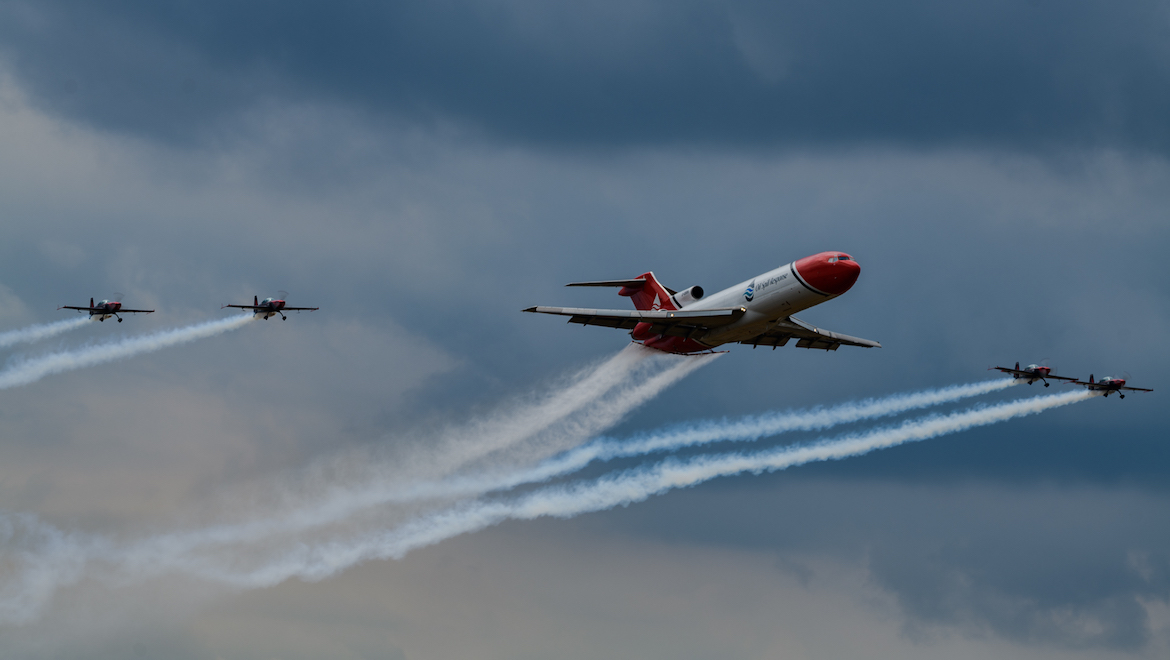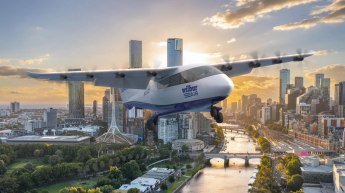It was safety first for some of the flying displays in light of the recent Shoreham tragedy but amidst the fluff and filler a few vertical dazzlers made the crowds collectively catch their breath, as Dave Unwin reports from the Farnborough Airshow.

As the Australian Aviation team waddled expectantly through Farnborough’s near airport-like security screening it was immediately apparent that where Thursday had been all about trade, Friday was going to be fluff and filler. It was also a STEM day, and there were huge packs of children roaming everywhere.
Indeed, the vast halls were almost eerily quiet as most of the “suited and booted” aerospace executives were long gone, although there were still a few interesting news snippets to pick up for the antipodean aviation enthusiast.
In a world where military flight training is an ever-increasing expense it is to be expected that synthetic trainers will become more prevalent, and when Grob’s chief instructor pilot and test pilot Thomas Reinert showed Australian Aviation the new G-PSES (Grob Pilot Selection and Evaluation System) it’s fair to say we were very impressed.
I first met Tom when I visited the Grob factory at Tussenhausen to flight test the TP120 trainer and G520 high altitude surveillance aircraft, and the company’s latest product is a fully automated system which uses virtual reality and other cutting-edge technologies to produce a standalone system which tests, assesses and grades pilot applicants. A full explanation of this revolutionary new pilot aptitude assessment system would require an entire article, but it certainly seemed extremely impressive.
During the morning, the endless procession of bizjets arriving and departing was enlivened by some very interesting arrivals, such as an Auster AOP.9 and DHC.2 Beaver from the Army Historic Aircraft Flight, a Consolidated Catalina, Folland Gnat and BAC Jet Provost, while already on the ground were some of Red Bull’s Flying Bulls fleet, such as the Douglas DC-6, North American B-25 Mitchell and Vought F-4U Corsair.
Obviously, we rather hoped that some of these machines would fly, but sadly Friday wasn’t their day.
Red Arrows offer “a couple of smoky passes”
At about 1130 the RAF’s world famous display team the Red Arrows pitched up in their scarlet-painted Hawk jets, but any hopes that they’d crank out a display were soon dashed. As it transpired they just made a couple of smoky passes, then pitched up out of formation for individual landings. I hoped that they’d at least land in formation but even that had clearly been deemed inappropriate.
In fact, although the Reds did display at Farnborough, in both 2012 and 2014, they flew a modified programme to ensure it fitted into the “Farnborough arena”. Furthermore, although the Breitling Jet Team displayed in 2012, it’s been a long time since any of the other major jet display teams (such as the Frecce Tricolori or Patrouille de France) appeared there. The bottom line is that, even though this decision is probably partly linked to the 2015 Shoreham tragedy (the case is still on-going), the world has moved on, both philosophically and physically.
The area around Farnborough airfield has changed beyond all recognition over the past 50 years, and the population density has risen exponentially. Should anything happen, the opportunities for a safe off-airfield arrival are very limited and, by definition, a display by a team of fast jets has an element of danger. When several aircraft are flying aerobatics in close formation — or approaching each other with a closing speed of around 1,200km/h, there is clearly some risk involved. Indeed, although fast jet accidents are infrequent they do still occur.

The Reds have lost two pilots and two Hawks in three separate incidents since 2010 while, in just one week in 2016, the USAF Thunderbirds, USN Blue Angels, the Russian Knights and the Patrouille de Suisse all lost aircraft. The Hunter disaster in 2015 — and to a lesser extent the Gnat crash at CarFest the following year—focussed the attention of the RAF and CAA in much the same way that the spectre of Ramstein still haunts German airshow organisers.
On that terrible day of 28 August 1988, 75 people died when a display by the Frecce Tricolori went horribly wrong. After this tragedy, airshows were completely banned in West Germany for several years, and even after the ban was lifted, very strict rules governing air displays remain in force. So, while I think we all miss seeing the Reds fly a full display at Farnborough, I think it’s the right decision. See them at the right venue, and the Reds will continue to put on a show that is as thrilling and dynamic as it ever was. But it does have to be the right venue.
Battle of Britain Memorial Flight
A couple of hours later, the unmistakable sound of six Rolls-Royce Merlins in close formation heralded the arrival of a Hurricane, Spitfire and the Lancaster of the Battle of Britain Memorial Flight as they rumbled through the overhead on their way to nearby RAF Odiham. Interestingly, when the airshow did get going it did seem to have a bit more zip and zest than the previous days, which everyone agreed (the Super Hercules’s amazing aerobatics aside) had been below par.
VIDEO: The C130 Super Hercules performing its flying display on Thursday July 19 at Farnborough 2018, from the Australian Aviation YouTube channel.
It was the Airbus A350 pilot’s last Farnborough before retiring, and he put on quite a show. Of course, we all know it’s flown at a very lightweight during its display, but nevertheless it really was quite a remarkable sight to see this leviathan practically hanging in the air at times.
The Red Bull Air Race demonstration gave the punters a flavour of the actual event, as several of the race course pylons were inflated out near the runway for the aircraft to race through. A now rare but very welcome visitor to Farnborough 2018 was an AV-8B Harrier of the Spanish Navy. For very many years the famous British “jump-jet” had been a perennial favourite of the airshow crowd. Farnborough had seen the public debut of the game-changing “ski jump” while the display flown by Harrier chief test pilot John Farley (who died recently) was always a wonder to watch. His famous vertical climb had to be seen to be believed!


The specially-adapted Boeing 727 also looked stunning as it climbed steeply into the sky while spraying water from its oil-dispersant delivery system while the Extra 300’s of The Blades aerobatic team buzzed busily about. The Calidus autogyro also put on a spirited display, as did the Turkish T129 attack helicopter.
The show was closed with a very vigorous exhibition of jet aerobatics from a Lockheed-Martin F-16. Although this fighter first flew more than 40 years ago, in the right hands it can still put on a show!















